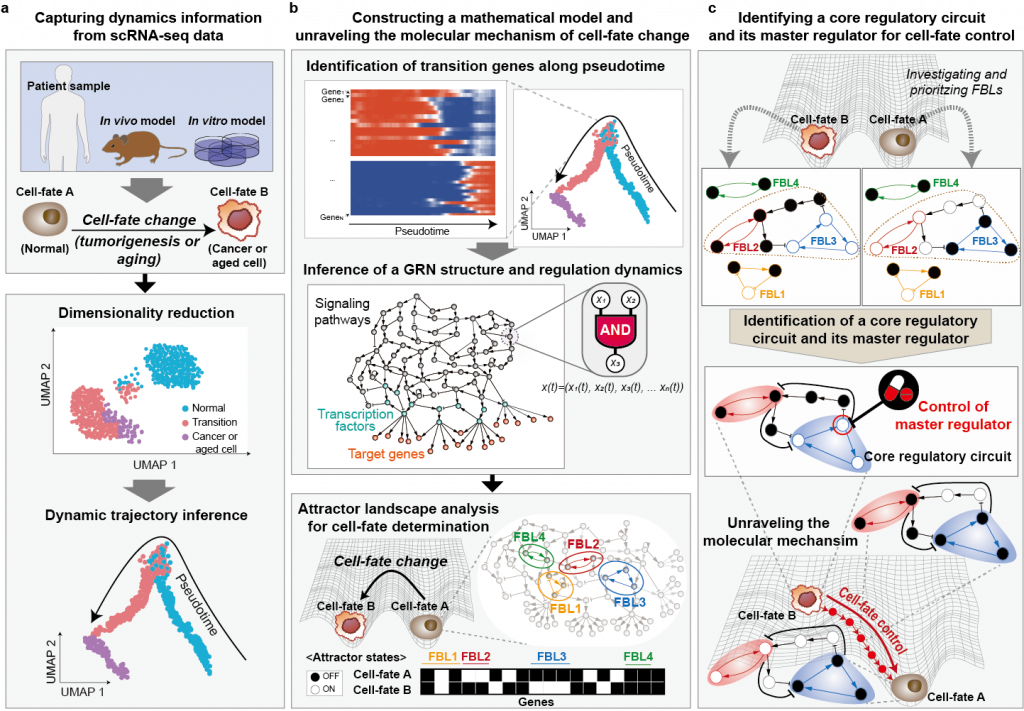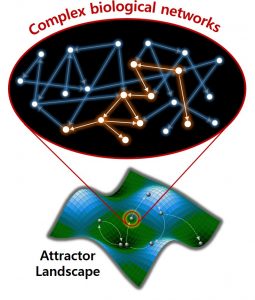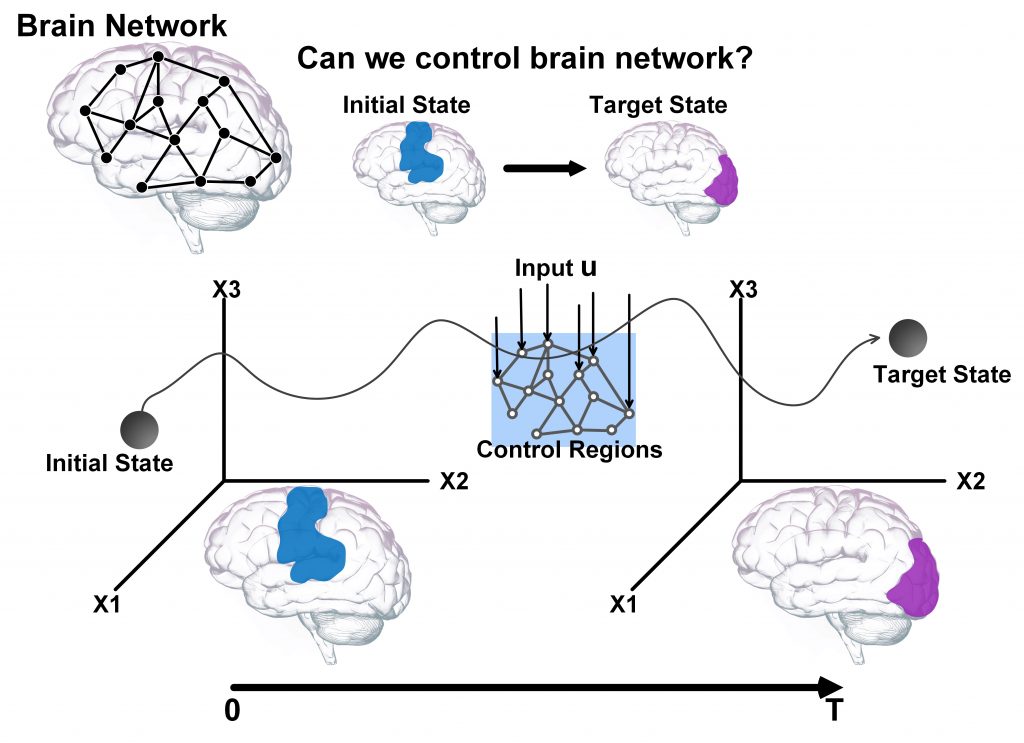1. 암과 노화의 가역화 연구 (Reverse Control of Cancer and Aging)

대표적인 복잡계 질환인 암(cancer)과 노화(aging)는 일반적으로 되돌릴 수 없는 비가역적인(irreversible) 현상으로 간주되고 있습니다. 하지만 놀랍게도 특정한 상황에서 이러한 현상이 되돌려질 수 있다는 실험적 관찰들이 보고된 바 있습니다. 그러나 아직 이에 대한 체계적인 메커니즘의 분석이나 실험적 검증이 이루어지지 않았습니다. 본 연구실에서는 이 문제에 도전하기 위해 컴퓨터모델링과 시뮬레이션 분석, 그리고 생물학실험을 융합하여 복잡한 생명현상 이면의 숨겨진 동작원리를 탐구하는 시스템생물학(Systems Biology)적 접근방법을 통한 창의적인 연구를 수행하고 있습니다. 이를 통해 암과 노화의 근본적인 메커니즘을 시스템 차원에서 새롭게 규명하고, 이를 제어하기 위한 혁신적인 치료전략을 개발하고 있습니다.
Can we reverse cancer and aging? These processes are regarded as irreversible biological phenomena in general. Surprisingly, experimental observations have been reported that these could be reversed under particular circumstances. However, no systemic analysis or experimental validation has been made for their reversion yet. To challenge this fundamental problem, we are conducting creative research using a systems biological approach that explores hidden operating principles behind complex biological phenomena by combining computer modeling, simulation analysis, and biological experiments. Therefore, the fundamental mechanisms of cancer and aging can now be identified at a system level, and we are developing innovative strategies to control and treat them through this process.
2. 단일세포 멀티오믹스 분석 및 이에 기반한 단일세포 시스템생물학 연구 (Single-Cell Multi-Omics Analysis and Single-Cell Systems Biology)

세포내 분자수준의 변화를 측정하는 기술은 비약적인 발전을 거듭해 이제는 단일세포 수준의 전사체와 공간전사체 등 다양한 멀티오믹스 데이터를 측정할 수 있게 되었습니다. 본 연구실에서는 분화, 노화, 암화 등 세포의 운명이 변화하는 과정에서 이러한 단일세포 멀티오믹스 데이터를 측정하고 분석하여 세포운명 변화의 핵심메커니즘을 찾아내고 나아가 세포운명을 우리가 원하는 방향으로 제어하기 위한 시스템 차원의 연구를 수행하고 있습니다.
Technologies for measuring molecular-level changes within cells have advanced significantly, allowing for the measurement of various multi-omics data, including single-cell transcriptomics and spatial transcriptomics. Our lab focuses on the measurement and analysis of single-cell multi-omics data during processes such as differentiation, aging, and carcinogenesis, where cellular fate undergoes transitions. By identifying the key mechanisms driving these cellular fate changes, we aim to conduct system-level research to precisely control cellular fate in targeted directions.
3. 개인 맞춤형 항암치료 시뮬레이션 연구
(Computer Simulation Analysis for Personalized Therapy of Cancer)

본 연구실에서는 생물학 빅데이터를 기반으로 암의 분자조절네트워크에 대한 컴퓨터 시뮬레이션 모델을 개발하고 있습니다. 특히 개별 환자들의 유전적 변이 정보를 컴퓨터 모델에 반영하여 시뮬레이션 분석함으로써, 환자별 특성을 고려한 최적의 개인맞춤형 항암 치료전략을 개발하고 있습니다. 이를 통해 정밀의학의 새로운 패러다임을 개척해가고 있습니다.
We are developing computer simulation models for molecular regulatory networks of cancer using biological big data. We particularly want to develop an optimal anti-cancer treatment strategy for individual patients by applying patient-specific genetic information for our computer simulation model. Our study will suggest a new paradigm for precision medicine.
4. 생명체 네트워크의 분석 및 제어 연구 (Analysis and Control of Biological Networks)

생명체를 구성하는 수많은 요소들은 서로 조절하는 관계를 통해 복잡한 네트워크를 형성하고 있습니다. 이러한 네트워크로 인해 발생되는 동역학적인 변화는 다양한 생명현상으로 나타나게 되며 생명체의 기능을 유지하는데 중요한 역할을 하게 됩니다. 따라서 우리가 원하는 방향으로 생명현상을 변화시키기 위해서는 이러한 복잡한 생명체 네트워크를 자세히 관찰하고 분석한 뒤 효과적으로 제어해야 합니다. 본 연구실에서는 시스템생물학 접근법을 통해 다양한 생명체 네트워크들의 구조적/동역학적 특성을 분석하여 그 특성을 탐구하고, 네트워크 제어 이론을 적용하여 복잡한 생명현상에 대한 제어전략을 개발하고 있습니다.
Living-systems are composed of biological components that are interacting each other to generate complex networks. These interactions in the networks cause dynamic changes that are manifested in various biological phenomena and play an important role in maintaining basic functions of life. Thus, we need to observe and analyze these complex biological networks in order to effectively control and manipulate biological phenomena. Through a systems biological approach, the structural/dynamic characteristics of various biological networks can be analyzed to explore their characteristics and ultimately develop an efficient control strategy for complex biological phenomena.
5. 브레인 네트워크 연구 (Brain Network Control)

생명체의 뇌신경 시스템은 시냅스 연결을 통해 이루어진 신경세포들의 거대한 네트워크로 표현될 수 있으며 이러한 네트워크로부터 발현되는 동역학적 현상들은 다양하고 복잡한 뇌의 기능을 나타냅니다. 예를 들어, 뇌 영역간의 주파수 선택적인 동기화 현상은 정상적인 뇌 기능을 유지하는데 필수적이며 이러한 동기화 과정에 문제가 발생하면 간질을 비롯한 여러 뇌 질환으로 이어지게 됩니다. 본 연구실에서는 다양한 뇌영상 데이터로부터 뇌 영역간의 연결망을 나타내는 브레인 네트워크를 구축하고, 이를 분석하여 브레인 네트워크의 동작원리를 시스템 차원에서 탐구하는 연구를 수행하고 있습니다. 그리고 여기서 더 나아가 네트워크 제어이론을 응용해 뉴로피드백을 위한 브레인 네트워크의 효율적인 제어전략을 개발하고 이를 통해 복잡한 뇌질환의 새로운 치료전략을 수립하며 차세대 인공지능 알고리즘 개발을 위한 브레인 네트워크 구조 응용 등 창의적인 연구들을 진행하고 있습니다.
The human brain can be represented by a vast network of neurons created through synaptic connections and dynamic phenomena through these networks with various complex brain functions. For example, frequency-selective synchronization between brain regions is essential to maintain normal brain function. In addition, problems that are caused during this synchronization process can lead to a number of brain disorders, including epilepsy. We build brain networks that represent connections between the brain regions from various neuro-imaging data and analyze them to explore the operating principles of brain networks at a system level. Furthermore, we have developed an efficient control strategy for neuro-feedbacks among brain networks by applying the network control theory. Therefore, establishing a new treatment strategy for complex brain diseases and applying properties of the brain networks are crucial in developing next-generation artificial intelligence.
6. 시스템생물학 기반의 바이오영감공학 연구 (Bio-inspired Engineering Based on Systems Biology)

본 연구실에서는 시스템생물학 연구를 통해 밝혀낸 복잡하지만 매우 정교하게 조절되고 있는 생명현상의 진화적 설계원리를 공학에 응용함으로써, 기존의 공학적 난제를 해결하고 혁신적인 공학시스템을 개발하는 바이오영감공학(Bio-inspired Engineering) 연구를 수행하고 있습니다. 예를 들어 스스로 고장을 복구하는 전자회로 하드웨어 개발, 노이즈에 강인한 음성인식 알고리즘 개발, 인간의 뇌신호처리를 모사한 저전력 회로설계 등의 연구를 수행하고 있으며, 이를 통해 현존하지 않는 새로운 개념의 공학 시스템을 개발하고 있습니다.
We are conducting bio-inspired engineering research that addresses existing challenges to develop innovative engineering systems by applying complex but highly sophisticated design principles of biological phenomena identified through a systems biological approach. For example, we are developing electronic circuit hardware that can repair failures on its own, developing sound recognition algorithms that are strong in noise, and designing low-power circuits that mimic human brain signals in order to develop new concepts of engineering systems that are not currently available.




